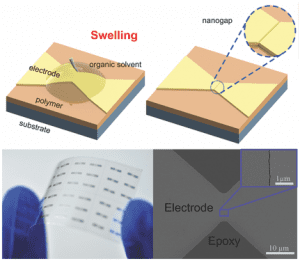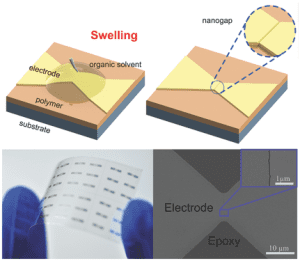Flexible electronics have attracted considerable attention over the recent years owing to their amazing applications. For defined flexible electronics, the electrode pair commonly serves as the fundamental building block of the device, and shortening the space of electrode pair has been proved to be an effective way to improve performance or reduce power consumption. However, fabricating nano-spaced electrodes on a large area flexible substrate cost-efficiently is still a great challenge.
Researchers at Xi’an Jiaotong University in China have developed a new, economical approach to fabricate nanogap electrodes on flexible substrates using a swelling controlled cracking method. Micron scale electrodes are fabricated on the surface of high polymer material substrates by conventional microelectronic processes, followed by controlled swelling of flexible substrate by organic solvent to realize the nano-cracking of microelectrodes.
This method has advantages of high applicability, parallel manufacturing capacity and compatibility with flexible substrates. Electrode pairs with tunable width can be realized by controlling the swelling and cracking properties. This convenient swelling-controlled cracking method provides a new way to fabricate high performance flexible electronics at a low cost. They demonstrate a flexible UV photodetector using ZnO nanoparticles bridged nanogap electrode. The photodetector shows an high stability, responsivity and external quantum efficiency.
The research also notes that the swelling controlled cracking method may have broad applications in flexible electronics including flexible displays, electronic skin and some other stretchable devices.
Text kindly provided by the authors of the original manuscript

















